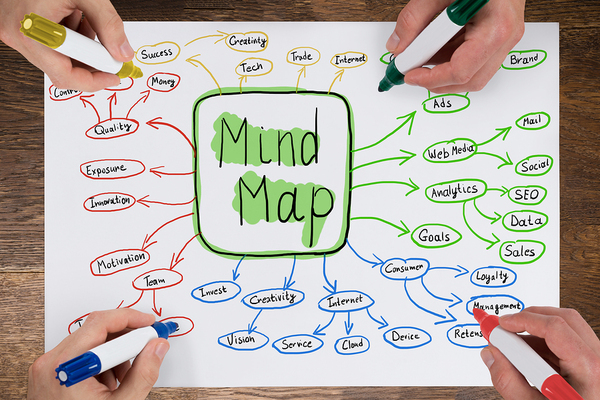
Mind maps can help students perform and learn better.
Mind mapping is a technique for organizing your thoughts, brainstorming, and other creative thinking activities. This technique has many uses for IT students and can be used inside the classroom or out of it.
How to BUILD a Mind Map
Mind maps are easy to make. Simply write your topic in the middle of the page, then draw lines radiating out from the middle to write down the ideas related to that topic. You can also draw lines from those subtopics to subtopics of those subtopics. Your mind maps will be different based on the use or purpose of the map.
Mind maps can be hand drawn on paper, or you can use a number of online tools for a more high-tech rendition. Coggle is a Chrome extension that lets you color code your maps; FreeMind is open source and allows you to work offline; and MindMapple lets you integrate clip art into your maps and share them with GoogleDrive, as well as being Mac compatible. Sketchboard lets you draw your mind map (or anything else) freehand for the best of both worlds.

Online tools can assist students with mind mapping.
How IT Students Can Use Mind Maps
When studying, IT students can use mind maps to organize information so they can remember it better, they can use them to take notes during class, or to review information to prepare for a test. They can also use mind maps to ensure that they understood what they read—mind maps have been shown to improve reading comprehension.
Another good use for mind maps is for solving IT problems, like practice problems designed to teach students how to troubleshoot real life situations and also in their IT careers when they do need to solve problems with servers, networks or other computer problems. Mind maps can help IT students brainstorm and work through these situations to come up with possible solutions.
Mind maps are also useful for writing essays, functioning as basically another way of making an outline that will help organize and flesh out the writing. Last but not least, mind maps can be used to organize and track group projects—preferably via an online tool that can be shared with all the group members to keep everyone up to speed.
The Biggest Benefit of Mind Mapping
The best thing about mind mapping is the way it lets students customize their learning to organize material in the way students can best relate to it. Being able to personalize content in the way that makes the most sense to each individual results in 12 percent higher test scores on average for students who use this method. Applying mind mapping to your IT course studies at PC AGE could help you excel, pass rigorous certification exams, and launch an IT career. Contact us to request information about our programs.
Rameez Khizer, IT Marketing
